
5 Best Twilio Alternatives for 2025 (Complete Review)
Grammarly’s 2024 report shows workers spend 88% of their week on communication tasks. This causes stress for over half of employees and lowers productivity for many.
As businesses grow, the tools they rely on for messaging, calls, and other communication must be scalable, cost-effective, and easy to use.
Twilio is a platform that allows businesses to integrate calls, texts, and more into their apps. Its features make it a favorite among developers.
However, Twilio may not be the perfect solution for every business. For some, costs can be prohibitive, setup and usage too complex, or compliance with evolving regulations challenging.
In this article, we will explore five Twilio alternatives for 2025, highlighting their unique features, pricing structures, and areas of specialization.

Get Started With Business Texting
View our pricing, and start your free trial with Textellent today!
Why Consider Twilio Alternatives

As the needs of businesses change, many are discovering that Twilio’s one-size-fits-all approach doesn’t always fit. Challenges like unexpected costs, limited automation, and compliance hurdles with the latest 10DLC regulations drive companies to explore alternatives.
Here’s why business might look for Twilio alternatives:
- Cost: Twilio can be expensive, especially for small businesses or startups. Unlike others, Twilio charges for incoming messages, which may increase or even double costs.
- Ease of use: Some find the tool too complex, and companies prefer something easier to set up and use, especially if they don’t have a big tech team.
- Specific services: Certain businesses might need specialized features like advanced automated texting or better integration options that Twilio doesn’t prioritize.
- Automated texting and flexible API: Automated texting features are important for reaching out to customers effectively. A flexible API is also key to smoothly integrating the service with other business systems. Businesses might switch if they find an alternative that offers these in a better way.
Compliance
Starting December 1st, 2024, U.S. phone carriers began blocking all unregistered 10DLC messaging.
Twilio users are encountering difficulties in this area, with many receiving rejections during the registration process and not getting enough support to resolve the issues.
This can lead to serious disruptions in their messaging capabilities and additional costs from penalties or surcharges for non-compliant messages. Downtime or missed opportunities can be costly.
Top 5 Twilio Alternatives
While Twilio is a popular choice, there are alternatives that offer specialized features, competitive pricing, and tailored solutions to meet diverse business needs. Below, we explore five top alternatives to Twilio and what makes each one stand out.
1. Textellent

Textellent is designed to make every interaction count by focusing on turning leads into customers and casual customers into loyal ones. It combines powerful automation, personalization, and performance tracking to help you see real results quickly.
Here’s what makes Textellent the best alternative to Twilio:
Automated Drip Campaigns for Engagement
With Textellent, businesses can create campaigns that send messages automatically based on customer actions or specific events.
After a customer asks for a quote, you can send a personalized follow-up message immediately, then schedule a series of texts to guide them toward booking an appointment or making a purchase.
This process keeps your brand in the customer’s mind, ensuring timely communication without overwhelming them. Drip campaigns can also nurture long-term leads by sending helpful updates, reminders, or special offers over time.
Personalized Campaigns That Feel Genuine
Textellent allows you to customize every message. Using customer names, past purchases, or events they’ve attended makes your communication more relevant and engaging. Instead of generic, one-size-fits-all texts, your messages feel personal, which increases response rates and builds trust.
You can send birthday greetings with a discount code or follow-up messages that refer to a product they recently viewed. Small personal touches make a big difference in how customers perceive your brand.
Smart Tags and Segmentation
Textellent’s tagging system helps you organize your customers based on their preferences, actions, or history. You can group customers who recently made a purchase, attended an event, or expressed interest in a service.
When you send messages to these groups, you can make them more specific and relevant. This targeted approach ensures your customers receive messages they care about, which boosts engagement and leads to higher conversions.
Trackable Results for Better Campaigns
Textellent’s analytics tools let you see how well your campaigns are working. You can track delivery rates, customer responses, and even conversions when links to booking pages or purchase sites are included in your messages.
This data helps you understand what’s working and what needs improvement. If a campaign isn’t driving enough responses, you can adjust the message or timing to improve results.
Ready-Made Templates for Quick Campaigns
Textellent has a library of message templates that save you time and ensure your texts look professional. These templates include pre-written messages for common scenarios like follow-ups, promotions, and reminders.
For multimedia messages (MMS), you can add images or videos to make your messages more engaging. This combination of convenience and creativity helps you quickly launch campaigns that capture attention.
Seamless Integration for Smarter Workflows
Textellent connects easily with popular CRMs like Salesforce and HubSpot, as well as other business tools. Integration keeps your customer data organized and helps automate tasks like sending reminders or follow-ups.
Why Choose Textellent?
Textellent is the best alternative to Twilio because of its focus on features that address real business needs. It easily organizes and targets your audience based on preferences, purchase history, events attended, or specific actions like estimates provided.
You can also measure the success of your campaigns by tracking response rates and conversions, especially when links to purchase pages or appointment scheduling are included.
Unlike platforms that address single stages, Textellent supports your entire customer lifecycle, from initial contact to post-purchase follow-ups, ensuring every interaction builds a stronger relationship.
Discover Textellent’s Pricing Plans
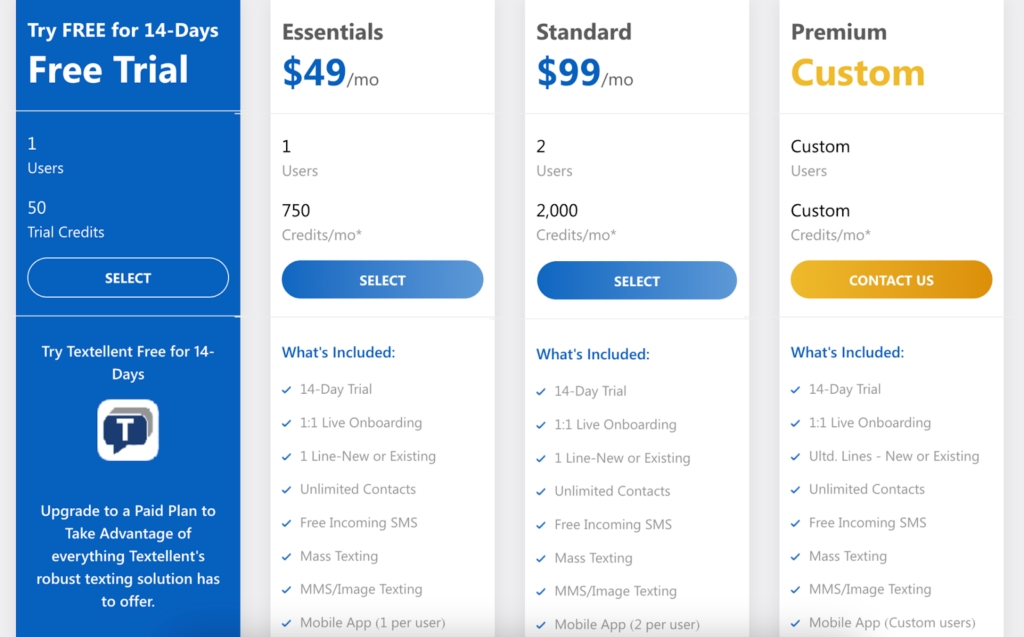
- 14-day free trial: Experience the platform with 25 SMS credits and access for one user to explore all the features.
- Essentials plan: Perfect for small businesses, this plan costs $49 per month and includes 750 credits to meet moderate messaging needs.
- Standard plan: Designed for growing businesses, this $99 per month plan offers 2,000 credits and additional features for more extensive messaging capabilities.
- Premium plan: Tailored solutions are available with custom pricing for businesses with specific messaging requirements.
Sign up for a free trial or request a demo consultation.
2. Nexmo (Vonage)
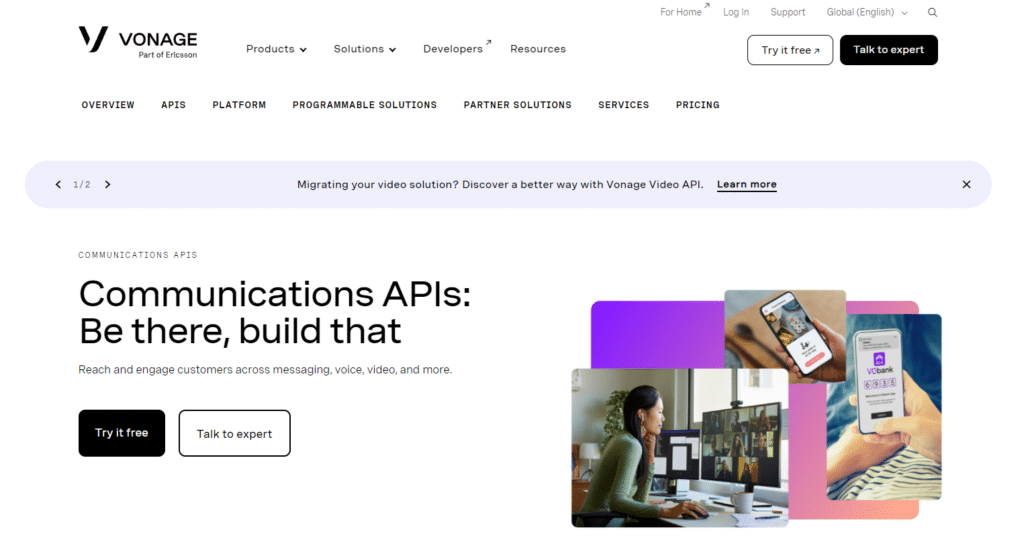
Source: Vonage.com
Nexmo, now under Vonage, offers a suite of cloud communication APIs designed to integrate with various applications.
It offers global SMS messaging and voice calls with features like recordings and IVR with video calling for app integrations.
Pricing
Nexmo uses a pay-as-you-go model, aiming to be cost-effective for businesses with high SMS and voice call volumes.
Pros
- Cost-effective for large-scale use
- Strong in international messaging with competitive rates
Cons
- Less extensive features and tools than Twilio
- Weaker documentation and support can make setup harder
3. Plivo
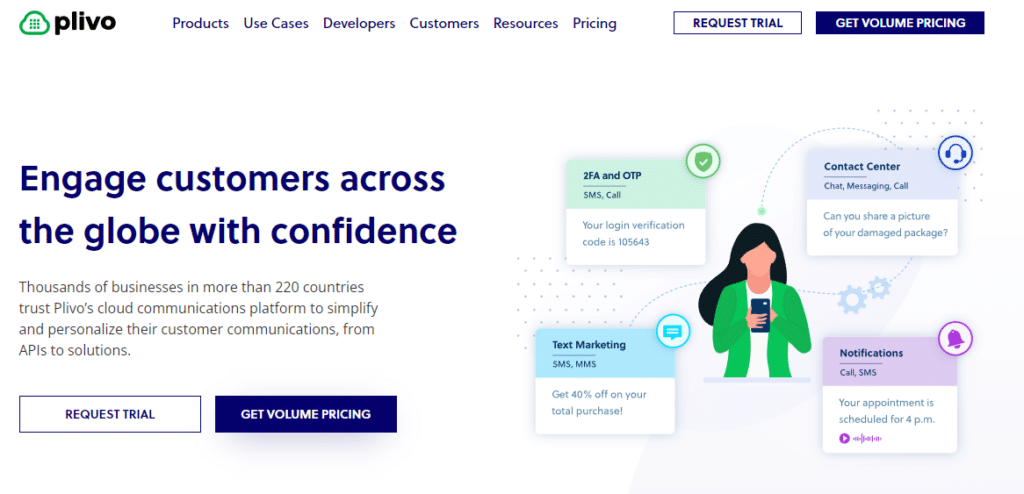
Source: Plivo.com
Plivo focuses on sending SMS globally and making voice calls designed for simplicity and efficiency.
It supports worldwide messaging, bulk SMS, and automated notifications. It also provides APIs for making and receiving calls with features like call forwarding and recording.
Their customizable APIs for messaging and calls also allow easy integration.
Pricing
Plivo uses pay-as-you-go pricing, often cheaper than Twilio, especially for large volumes of SMS and calls. It offers discounts for high volumes.
Pros
- More affordable for SMS and voice services
- Easier to use APIs and documentation
Cons
- Fewer advanced features and tools compared to Twilio
- Smaller developer community and fewer integrations
4. Bandwidth
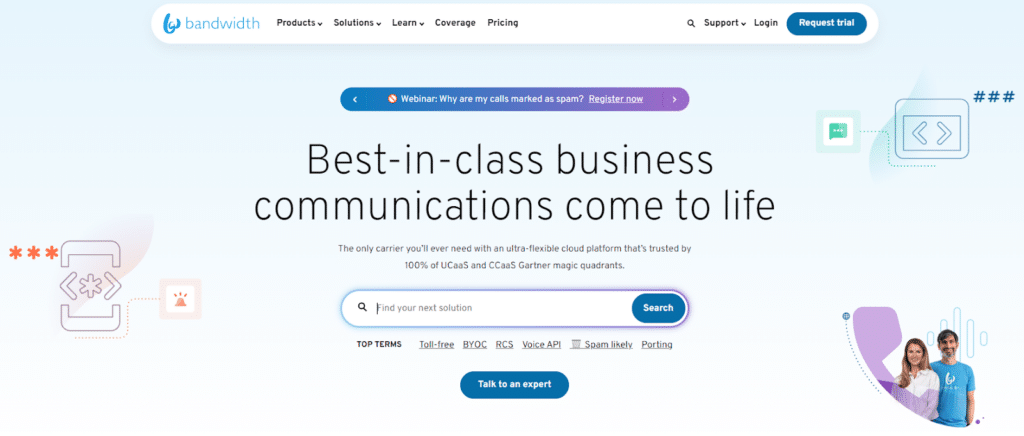
Source: Bandwidth.com
Bandwidth Inc. offers services to international and local businesses for voice calls, text messaging, and emergency services through software tools. They use their own global network for these communications.
It offers quality voice services with features like call recording and conferencing. Its system can support SMS and MMS for various types of communication. It also provides emergency call features, essential for VoIP services.
Pricing
Pricing is competitive, especially for voice services, with plans designed for businesses with high usage. The direct carrier approach helps keep costs down for these users. For example, the pricing for outbound SMS ranges from $0.004 to $0.040 per message.
Pros
- Better call quality and reliability through direct carrier connections
- Essential for businesses needing 911 access
- More affordable voice services for large volumes
Cons
- Fewer features outside of voice and emergency services
- Smaller developer community and fewer integrations compared to Twilio
5. Sinch
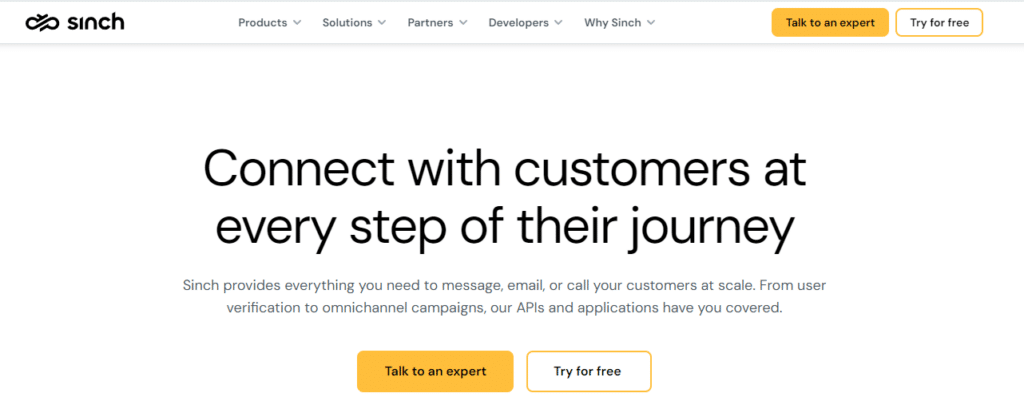
Source: Sinch.com
Sinch, previously known as CLX Communications, is a platform that helps businesses communicate with their customers through messages, voice calls, and emails.
It can support SMS, MMS, and chat apps, including features like voice and video calls. They also offer video calls, group sessions, and broadcasts that use SMS, voice calls, and flash calls for user verification.
Pricing
Sinch uses a pay-as-you-go model with competitive rates, especially for high-volume users, and provides custom solutions for larger enterprises.
Pros
- Wide messaging capabilities and support for chat apps
- Strong in video communication
- Focuses on verification for added security
Cons
- May lack some advanced features and developer tools found in Twilio
- Smaller developer community and less extensive support materials
Should You Switch to Automated Texting?
Switching to automated texting can transform how you connect, making customer interactions more immediate, personal, and efficient. Among the alternatives, Textellent stands out as the best.
Unlike Twilio, which covers a broad range of communication services, Textellent focuses solely on SMS. This focus means every feature specifically enhances text messaging, from targeted campaigns to efficient mass texting.
If your business relies on sending a high volume of texts, Textellent’s pricing model is designed to offer more value, ensuring you get the most out of your investment in automated texting services.
Say Goodbye to Complicated SMS Campaigns With Textellent
Looking to improve your business’s customer engagement? Textellent offers easy-to-use features designed just for texting, affordable rates, and solid customer support.
Don’t let complexity slow your marketing strategy. Choose Textellent for a hassle-free way to launch impactful SMS campaigns. Sign up for a free trial or request a demo consultation today.
FAQs About Twilio Alternatives
Do Twilio alternatives offer the same range of communication services, like SMS, voice, and video?
Most alternatives focus on providing a broad range of services, but their specializations and feature sets can vary. It is important to evaluate whether an alternative excels in the specific services your business needs.
How do I migrate from Twilio to another service?
Migration involves exporting your data reports from Twilio, setting up your new service, and possibly adjusting APIs or integrations. Look for providers that offer migration support.
How do the pricing models of Twilio alternatives compare?
Pricing models for messaging services vary, with some alternatives offering more transparent, usage-based pricing, while others might provide tiered plans. Comparing costs involves looking at both the base fees and the cost of additional usage or features.






